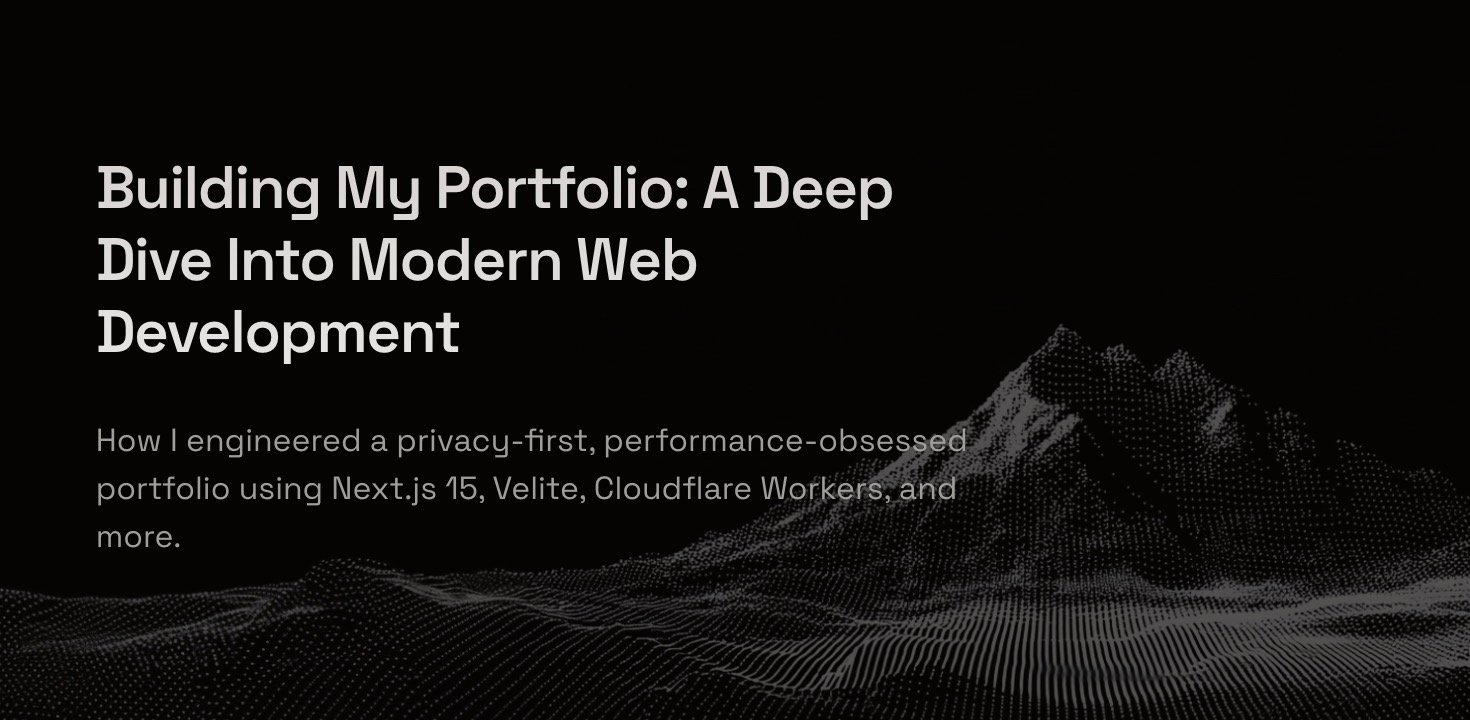Note: This article was copy-edited using Large Language Models (LLMs) to improve clarity and readability while preserving the original technical content and insights.
Creating a personal site that loads in milliseconds, respects user privacy, and remains maintainable is challenging in 2025. This post walks through every architectural choice behind this portfolio, so you can replicate—ahem—over-engineer it yourself.
My Core Values in Web Development
Before diving into the technical stack, let me be clear about what drives every decision:
- Performance Obsession: Every millisecond matters. If it doesn’t make the site faster, it doesn’t belong.
- Clean UX: Users shouldn’t think about how to use your site—they should just use it.
- Privacy First: Zero tracking without explicit consent. User data is sacred.
- Accessibility Always: The web should work for everyone, regardless of ability or assistive technology.
- The Right Way: Standards-compliant, maintainable code that respects both users and developers.
These aren’t just nice-to-haves—they’re non-negotiables that shaped every architectural choice.
Why Next.js 15 for Static Site Generation
While Astro, Hugo, and Gatsby offer compelling alternatives, I chose Next.js 15 for its unmatched developer experience within the React ecosystem and future-proof architecture.
- Performance by Design: Next.js optimizations (automatic code splitting, image optimization, prefetching) are performance wins I don’t have to implement myself
- Future-Proofing with RSC: React Server Components are the future. By choosing Next.js now, I can gradually adopt RSC patterns when I need dynamic features without a complete rewrite
- Clean DX = Clean UX: Superior developer experience directly translates to better user experience through faster iteration and fewer bugs
- Static Export Flexibility: Full static export capability while maintaining the option to add dynamic routes later—the right foundation for scalable growth
- Built-in Best Practices: Image optimization, font loading, and bundle splitting work perfectly out of the box
The key insight: Next.js isn’t just for dynamic apps. Its static export mode generates pure HTML/CSS/JS that can be deployed anywhere, while keeping the door open for future enhancements—exactly the right balance of simplicity and flexibility.
Content Management: Why Velite Over Everything Else
For content management, I evaluated Contentlayer, Content Collections, and others before settling on Velite. Here’s why Velite won:
The Competition’s Shortcomings
- Contentlayer: No longer actively maintained, which raises long-term viability concerns despite its excellent TypeScript integration
- Content Collections: A solid, actively maintained option with first-class Next.js support and better community adoption. However, it currently lacks support for JSON/YAML content and doesn’t have incremental watch mode yet
Why Velite is the Right Choice
- Comprehensive Format Support: Built-in processing for Markdown, MDX, YAML, and JSON with automatic relative file and image optimization, plus robust schema validation—everything you need in one cohesive system
- Zod-Powered Validation: Content schema validation powered by Zod with automatic TypeScript definition generation—catch content errors at build time, not runtime
- Infinitely Extensible: Custom loaders for any file type, flexible schema transformations, and configurable output formats through hooks—adapt to any workflow without constraints
- Modern MDX Pipeline: Integrates
remarkMath,rehypeSlug,rehypeAutolinkHeadings,rehypeKatex, and Shiki syntax highlighting without configuration hell
Instant, Private Search with Pagefind
Search is a UX necessity, but most solutions compromise privacy or performance. Pagefind, built in Rust for maximum performance, solves both:
- Zero Server Cost: Fully client-side indexing and search—scales to millions of pages at no extra cost
- Privacy Perfection: No requests to external servers, no user tracking, no data collection
- Performance First: Lazy loading keeps initial bundle tiny, search loads only when needed (⌘+K)
- Clean UX: Instant results with fuzzy matching that feels magical to users
This is search done the right way: fast, private, and progressively enhanced.
Hosting on Cloudflare Workers via OpenNext
Deploying a static portfolio on Cloudflare Workers using OpenNext is admittedly over-engineered—but aligns with my performance obsession:
- Global Performance: 250+ PoPs mean every user gets millisecond response times
- Platform Recommendation: Cloudflare now advocates Workers over Pages for advanced feature integration
- Vendor Independence: OpenNext preserves deployment flexibility—switch between Vercel and Cloudflare in minutes
- Future-Proof Architecture: Edge-native design patterns that scale from personal sites to global applications
Honest confession: I’ll never hit Vercel’s free-tier limits for a simple portfolio, and the few-millisecond edge benefit is negligible for most users. But my obsession with performance and learning edge runtimes justified this choice—sometimes over-engineering teaches you exactly what you need for the next project.
Perfect Lighthouse Scores
Achieving 100/100 across all Lighthouse categories—Performance, SEO, Accessibility, and Best Practices—isn’t about gaming metrics. It’s about respecting users:
- Performance: Static generation eliminates server response time, while Next.js automatically optimizes images, fonts, and JavaScript bundles for minimal render blocking
- Accessibility: Semantic HTML, proper heading hierarchy, comprehensive alt text, and keyboard navigation ensure the site works for everyone
- SEO: Structured data, optimized meta tags, clean URLs, and fast Core Web Vitals scores signal quality to search engines
- Best Practices: HTTPS everywhere, secure headers, modern image formats, and no deprecated APIs create a trustworthy experience
Perfect scores aren’t vanity metrics—they’re proof that you can have both excellent UX and ethical practices.
Google Analytics: Privacy-Conscious Power
Despite privacy-conscious alternatives—Plausible, Fathom, Umami, Cloudflare Analytics—Google Analytics remains unmatched for actionable insights:
- Real-Time Understanding: Immediate insights into user behavior and content performance
- Deep Segmentation: Understand not just what users do, but why
- Zero-Cost Enterprise Features: Advanced dashboards and integrations that competitors charge hundreds for
The key is implementing it the right way: strict privacy defaults, IP anonymization, and transparent consent mechanisms that actually increase opt-in rates by building trust.
Key Lessons: Performance, Privacy, and Principles
- Performance is UX: Every optimization directly improves user experience—there’s no separation
- Privacy Builds Trust: Transparent, user-first data practices increase engagement and conversions
- Standards Aren’t Optional: Accessible, semantic code benefits everyone and costs nothing extra
- Over-Engineering Has Purpose: Sometimes the “excessive” choice teaches you exactly what you need for production systems
The pursuit of perfect performance, clean UX, and ethical privacy practices never ends—it just gets more refined.
